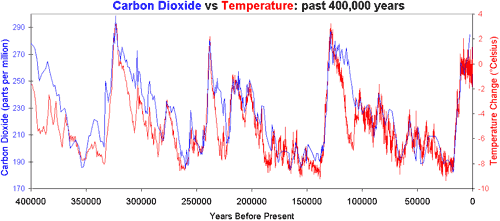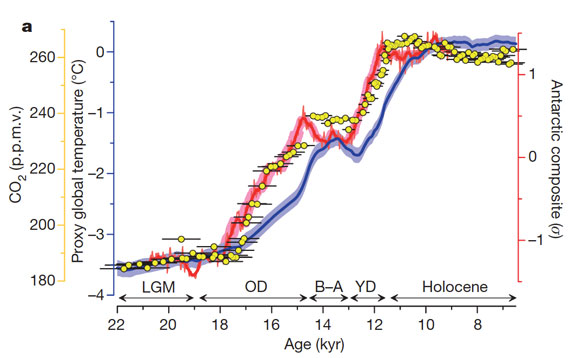CO2 lags temperature - what does it mean?
What the science says...
| Select a level... |
|
|  Intermediate Intermediate |
|  Advanced Advanced | ||
CO2 didn't initiate warming from past ice ages but it did amplify the warming. | |||||||
CO2 lags temperature
"An article in Science magazine illustrated that a rise in carbon dioxide did not precede a rise in temperatures,
but actually lagged behind temperature rises by 200 to 1000 years.
A rise in carbon dioxide levels could not have caused a rise in temperature if it followed the temperature."
(Joe Barton, US House of Representatives (Texas) 1985-2019) - Full Statement
Earth’s climate has varied widely over its history,
from ice ages characterised by large ice sheets covering many land areas, to warm periods with no ice at the poles.
Several factors have affected past climate change, including solar variability, volcanic activity and changes in the composition of the atmosphere.
Data from Antarctic ice cores reveals an interesting story for the past 400,000 years.
During this period, CO2 and temperatures are closely correlated, which means they rise and fall together.
However, based on Antarctic ice coredata, changes in CO2 follow changes in temperatures by about 600 to 1000 years, as illustrated in Figure 1 below.
This has led some to conclude that CO2 simply cannot be responsible for current global warming.

Figure 1: Vostok ice core records for carbon dioxide concentration and temperature change.
This statement does not tell the whole story.
The initial changes in temperature during this period are explained by changes in the Earth’s orbit around the sun,
which affects the amount of seasonal sunlight reaching the Earth’s surface.
In the case of warming, the lag between temperature and CO2 is explained as follows: as ocean temperatures rise,
oceans release CO2 into the atmosphere. In turn, this release amplifies the warming trend, leading to yet more CO2 being released.
In other words, increasing CO2 levels become both the cause and effect of further warming.
This positive feedback is necessary to trigger the shifts between glacials and interglacials,
as the effect of orbital changes is too weak to cause such variation.
Additional positive feedbacks which play an important role in this process include other greenhouse gases,
and changes in ice sheet cover and vegetation patterns.
A 2012 study by Shakun et al. looked at temperature changes 20,000 years ago
(the last glacial-interglacial transition)
from around the world and added more detail to our understanding of the CO2-temperature change relationship.
They found that:
- The Earth's orbital cycles triggered warming in the Arctic approximately 19,000 years ago,
- causing large amounts of ice to melt, flooding the oceans with fresh water.
- This influx of fresh water then disrupted ocean current circulation,
- in turn causing a seesawing of heat between the hemispheres.
- The Southern Hemisphere and its oceans warmed first, starting about 18,000 years ago.
- As the Southern Ocean warms, the solubility of CO2 in water falls.
- This causes the oceans to give up more CO2, releasing it into the atmosphere.
While the orbital cycles triggered the initial warming,
overall, more than 90% of the glacial-interglacial warming occured after that atmospheric CO2 increase (Figure 2).
Figure 2: Average global temperature (blue), Antarctic temperature (red), and atmospheric CO2 concentration (yellow dots). Source.
















 Basic
Basic
Climate Myth...